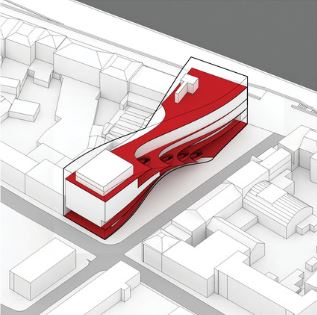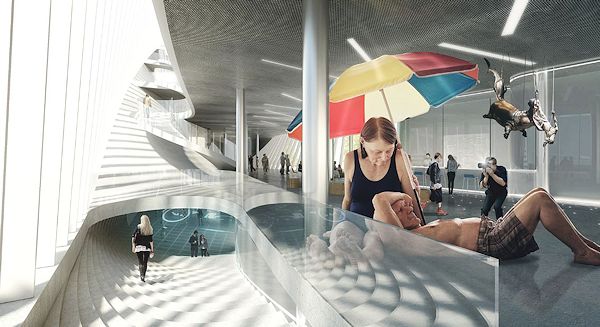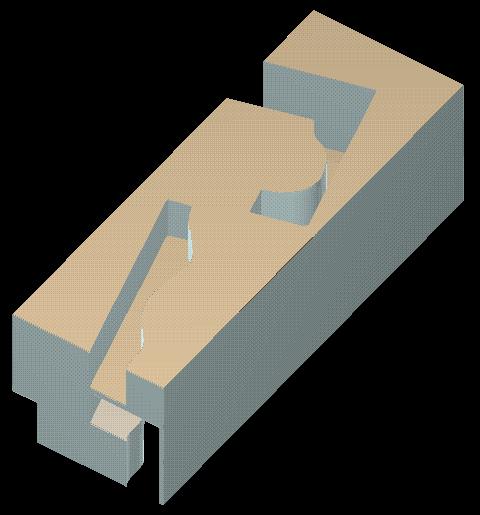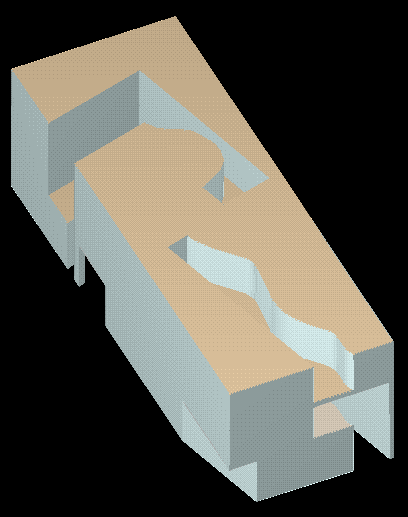1998.04.03
B. F. Parkway: An Interpolation
...the Parkway as virtual space from its very inception.
00040301 House in Laguna 002 perspectives
2322i02
2001.04.03 21:29
dash plates
I got the book Mutations via amazon yesterday.
2002.04.03 09:25
[architect of] Church of the Nativity, Bethlehem
I wonder if Flavia Julia Helena Augusta ever imagined that the Church of the Nativity would be a big part of world news just after Easter 2002 as she was first building this Church in AD 325-26.
The basilica at Bethlehem today is [I believe] a sixth century apposition to the original 'Helennian' structure. The interior columns, however, are still the ones Helena chose.
Before Helena, the Nativity site at Bethlehem was a cave.
Helena is also the (undisputed) 'buildier' of the Church of the Ascension, but that basilca no longer exists. A mosque is now on that site.
2002.04.03 09:37
[art] being/appositional [to architecture]
Is it correct to think of art as being largely appositional to architecture?
I'm not only thinking of how painting and/or sculpture and/or electronic display screens, etc. are added layers to architecture, which in turn manifest a 'new' entity, but I'm also thinking/wondering about the 'art of architecture' also being appositional to architecture itself.
This leads to now wonder if electricity (and other utilities) might also be (rightly) considered as appositional to architecture.
Conversely, is it (ever) possibly for architecture to be appositional to art? Or is it (ever) possible for architecture to be appositional to electricity?
2002.04.03 11:01
Re: [art] being/appositional [to architecture]
David wrote:
It depends on how abstruse and removed from the common use of the word [ie, apposition] you would like to get...and beyond that, how much faith you have in that interpretation.
Steve replies:
Personally, I do have faith in 'apposition' being apposite the notion of art being a successive layer to architecture. Moreover, common usage of 'apposition' does not necessarily preclude successive layers of meaning being added to the common usage.
My line questioning was not directed so much to the usage of the common word, rather to the notion of successive layers relative to the makeup of art vis-a-vis architecture, a reality that exists no matter what word is used to descibe it. [And if anyone can offer a better word that applies to this reality, then please do.]
If all this questioning and labeling is 'uncommon', then all the more reason for opening it to "public disputation."
As Lao-Tzu said, "If the shoe fits, the foot is forgotten. And if the belt fits, the belly is forgotten."
Or as I once wrote in a square poem, "All reality is relative to the vastness of its container."
2002.04.03 11:15
Re: [art] being/appositional [to architecture]
In Webster's Third New International Dictionary (1969) you will find the following definitions:
apposition beach : one of a series of beaches successively formed on the seaward side of an older beach
apposition eye : a compound eye that is characteristic of diurnal insects and in which entering light reaches the retina of each ommatidium as a single spot and the image is a composite of all the spots
2005.04.03 13:21
Books to give parents so they understand what architecture is
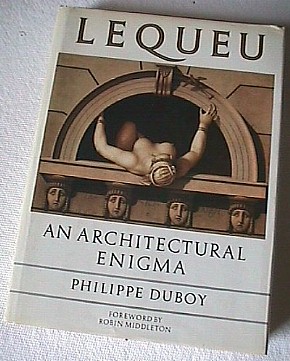
Why not scare your parents even more? Give them nightmares even --
Philippe Buboy, Lequeu: An Architectural Enigma (Cambridge,MA: The MIT Press, 1987).
| |
2005.04.03 14:34
John Paul II Dies
A little off topic, but who is the US ambassador to DisneyLand? That's a soverign state too, isn't it?
2005.04.03 16:57
Fashion Trends
There's really only one trend, and that's planned obsolescence.
2006.04.03 14:58
Re: Constantine and Christians
My general answer is that Helena and Eutropia were extremely influential over Constantine when it came to Christianity--Christianity was at that time pro women's rights. Constantine my have also had a great dislike of the more homosexually oriented Pagan cults--now there's a future irony.
Did Constantine see the embrace of Christianity as a way to "re-unify" the Empire?
I'd say that Constantine's main reason for presiding over the Arian Controversy was to establish himself as (still) head over "church" and state.
2006.04.03 15:54
Re: Constantine and Christians
I too thought of the Donatist controversy, (as preceding the Arian controversy), but I was more thinking of that controversy revolving around whether those Christian leader who gave up the faith under the Great Persecution should be allowed back into the Church. I was not aware (or had just forgotten) about the return-of-property issue, which I find much more provocative in that after 326 Constantine began to condemn (and seize the property of, I assume) Pagan cults with homosexual orientations.
I've always been curious if being a Roman emperor automatically meant that you were the wealthiest land owner in/of the Empire as well?
2006.04.03 16:25
Re: Constantine and Christians
I'd like to mention that Krautheimer, in Corpus Basilicum Christianum Romae, offers the possibility that the Basilica Constantiniani, today's Basilica of St. John Lateran, the first Constantinian basilica of Rome, may have been started as early as November 312. If this is indeed the case, then we have Constantine giving land and a major church building to Christians, in this case the Pope, even before the Edict of Milan.
2006.04.03 17:22
Re: Constantine and Christians
Here is the Krautheimer footnote:
Construction [of the Basilica Constantiniani] need not have taken many years. The huge Basilica Nova [another building] with its time-consuming vaulting system was built and completely decorated in four or five years; and we shall see that at St. Peter's construction and interior decoration were presumably completed in the course of six to eight years. The Lateran basilica, being smaller than St. Peter's, might well have been built and finished within five or six years. Dates given for the consecration are numerous, varying from 315 to 324, but they are never based on any sources. The Martyrologium Romanum gives November 9 as the feast day of the basilica, "Romae dedicatio Basilicae Salvatoris." However, as pointed out by Lauer, the date occurs first in the second version of the Descriptio Ecclesiae Lateranensis, 1153-1154: "Cuius dedicatio per totum orbum quinto idus novembris...celebratur..." By that time, then, the tradition was well established, but we do not know how far back it went. It is certainly older than the twelfth century, but it does not occur in the early sacramentaries and martyrologia dating from the fifth to ninth century. Is it, then, the date of a reconsecration after the rebuilding by Sergius III (904-911)? This is possible, but it is equally possible that the tradition springs from a fourth century root. We leave the question open. In any event, no year is given. However, it is curious that in the reigns of Constantine and Sylvester, November 9 falls on a Sunday--since the Middle Ages the customary day for church consecrations--only four times: 312, 318, 329, 335. The last two dates can be dispensed with: the period of construction [beginning from] 313 or 314 would be too long. However, 318 would be a very plausible date for the consecration of the church. Or should we stress the choice of the word dedicatio, rather than consecratio, by the sources? Dedicatio in Roman legal language is the act of handing over or ceding--dedere--an object, be it real estate or something else, to a deity; the act of consecratio follows, once the object has been installed or the shrine, temple or whatever, has been built. Is it possible, then, that November 9, 312, not quite two weeks after his coanuest of Rome, was the day Constantine ceded to Christ the terrain on which the basilica was to be built and made the endowment for its future maintenance, in servitio luminum?
----------
I'm not sure of the date of this text, but I vaguely remember it being before World War II. I do remember, however, that the first time I read this text was November 9, 2000.
2006.04.03 17:50
Re: Constantine and Christians
Just for reference regarding the possible beginning date of the Basilica Constantiniani, according to Timothy Barnes in The New Empire of Diocletian and Constantine, Constantine was at Rome 29 October 312 to January 313, and at Rome 21 July 315 to 27 September 315, and at Sirmium (in today's Serbia) 24 October 318 to 13 April 319. The only other time Constantine was at Rome was 18 July 326 to 3 August 326, and he never returned to Rome after that.
| |
2006.04.03 18:44
Pete vs. Rem, political campaign of the century
Like I said here before, "In the future everything will be an advertisement."


Advertising seems to always be the winner regardless of the votes.
2007.04.03 14:20
AN ARCHITECTURE OF REMOVEMENT
All I did was look to see what was 'winning' in the architecture magazines while Matta-Clark was in architecture schools.
As to holes is walls, note the PMP to Mikveh Israel connection.
07040301 5233 Arbor Street within the Philadelphia Museum of Art plans
2166i19
07040302 5233 Arbor Street plans
2166i20
15040301 OMA Paris-Saclay Campus LabCity Building Paris
18040301 Frank Gehry Beachfront Restaurant Los Angeles
20040301 iiq08 model work 2348i32
21040301 novel architecturale iqq19 Parc OMA plans Pergerson Interchange model work 2481i16
21040302 Courthouse Plus Ultra Villa + 15 models 2399i11
|



